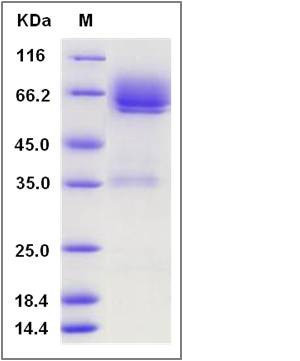Mouse LYVE1 / LYVE-1 Protein (Fc Tag)
1200012G08Rik,Crsbp-1,Lyve-1,Xlkd1
- 100ug (NPP3396) Please inquiry
| Catalog Number | P50065-M02H |
|---|---|
| Organism Species | Mouse |
| Host | Human Cells |
| Synonyms | 1200012G08Rik,Crsbp-1,Lyve-1,Xlkd1 |
| Molecular Weight | The recombinant mouse LYVE1 /Fc is a disulfide-linked homodimer. The reduced monomer comprises 446 amino acids and has a predicted molecular mass of 49.1 kDa. The apparent molecular mass of the protein is approximately 63 kDa in SDS-PAGE under reducing conditions due to glycosylation. |
| predicted N | Ala 24 |
| SDS-PAGE |  |
| Purity | > 85 % as determined by SDS-PAGE |
| Protein Construction | A DNA sequence encoding the mouse LYVE1 (Q8BHC0) (Met1-Gly228) was expressed, fused with the Fc region of human IgG1 at the C-terminus. |
| Bio-activity | |
| Research Area | Cancer |Invasion microenvironment |Adhesion molecule |Extracelluar matrix |Hyaluronan and HA-binding proteins |
| Formulation | Lyophilized from sterile PBS, pH 7.4 1. Normally 5 % - 8 % trehalose, mannitol and 0.01% Tween80 are added as protectants before lyophilization. Specific concentrations are included in the hardcopy of COA. |
| Background | LYVE1, also known as LYVE-1, is a type I integral membrane glycoprotein. It contains 1 Link domain and mainly expressed in endothelial cells lining lymphatic vessels. LYVE1 acts as a receptor and binds to both soluble and immobilized hyaluronan. It may function in lymphatic hyaluronan transport and have a role in tumor metastasis. LYVE1 also is a cell surface receptor on lymphatic endothelial cells that can be used as a lymphatic endothelial cell marker, and sort these cells for experimental purposes. It also functions as a ligand-specific transporter trafficking between intracellular organelles and the plasma membrane. It plays a role in autocrine regulation of cell growth mediated by growth regulators containing cell surface retention sequence binding. It may act as an hyaluronan transporter, either mediating its uptake for catabolism within lymphatic endothelial cells themselves, or its transport into the lumen of afferent lymphatic vessels for subsequent re-uptake and degradation in lymph nodes. |
| Reference |
